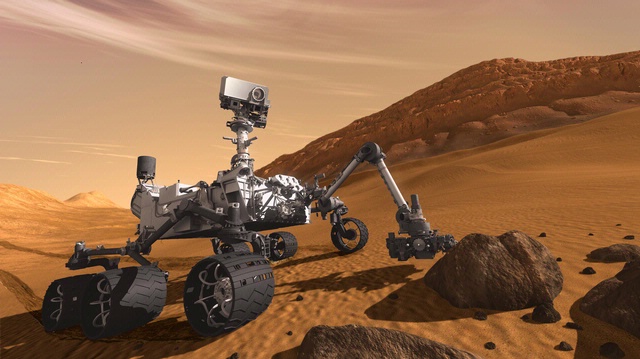
Mars Rover Discovers Chocolate on Mars
Apr 01, 2013
By David Romanowski
Scientists at the National Air and Space Museum’s Center for Earth and Planetary Studies announced an astounding discovery at a press conference this morning: the NASA Mars rover Curiosity has found chocolate on Mars.*
“Definitely more than just a trace,” said CEPS spokesperson Dr. John Grant. “More than a trace, less than a Snickers. But there could be more.”
“We were completely blindsided by this,” he said. "The Gale Crater area of Mars is about the last place you’d look for chocolate if you were looking for chocolate on Mars, which we weren’t.”
 This color panorama shows a 360-degree view of the landing site of NASA's Curiosity rover, including the highest part of Mount Sharp visible to the rover. That part of Mount Sharp is approximately 12 miles (20 kilometers) away from the rover.
This color panorama shows a 360-degree view of the landing site of NASA's Curiosity rover, including the highest part of Mount Sharp visible to the rover. That part of Mount Sharp is approximately 12 miles (20 kilometers) away from the rover.
“Here we were, searching for evidence of whether Mars was ever habitable, and we found this. Complete surprise. Curiosity was scraping away some surface materials and unearthed this small, dark, irregularly shaped mass,” Grant said, showing a sharp, close-up photo of the find, which looked vaguely like a Hershey’s bar left out on the beach.
“The initial chemical analysis was perplexing. We were prepared for the possible discovery of organic substances of some sort, but nothing like this. We ran the numbers and scratched our heads, then suddenly realized, ‘Whoa! This is, like, 90 percent cocoa, at least. Maybe more!’ Very pure stuff. Very exciting.”
The discovery begs the obvious question, where did the chocolate come from? Could it be a contaminant introduced by Curiosity itself? Perhaps a smudge left on the rover by a sloppy technician with sticky hands? “No way,” Grant asserted. “the rover is extremely clean and virtually sterile at launch. And because of the nature of the deposition, we don’t think it was a candy bar accidentally dropped by a passing alien or something. It’s a mystery.”
When asked about the prospect of beds of chocolate on Mars that could perhaps be mined and used to sustain future explorers on the Red Planet, Grant laughed. “That’s just science fiction,” he said. “For now anyway. We don’t even know how much there is, but we’re certainly going to try and find out.”
The discovery clearly has profound implications for science and for humanity. It presents many consequential questions that scientists and others will now begin to grapple with. Of most immediate importance? Grant says: “Is it edible?”
*April Fools!
Related Topics
You may also like

We rely on the generous support of donors, sponsors, members, and other benefactors to share the history and impact of aviation and spaceflight, educate the public, and inspire future generations. With your help, we can continue to preserve and safeguard the world’s most comprehensive collection of artifacts representing the great achievements of flight and space exploration.
Support the Museum
We rely on the generous support of donors, sponsors, members, and other benefactors to share the history and impact of aviation and spaceflight, educate the public, and inspire future generations. With your help, we can continue to preserve and safeguard the world’s most comprehensive collection of artifacts representing the great achievements of flight and space exploration.




